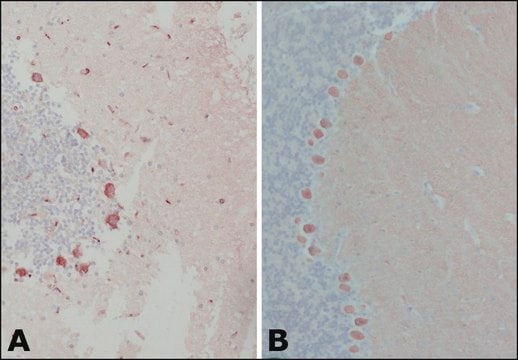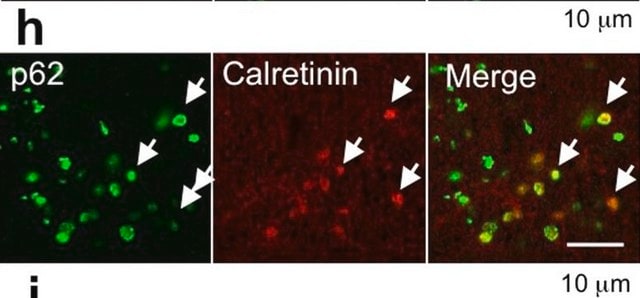推荐产品
生物源
rabbit
品質等級
抗體表格
affinity isolated antibody
抗體產品種類
primary antibodies
無性繁殖
polyclonal
物種活性
mouse, human, rat
包裝
antibody small pack of 25 μL
技術
immunocytochemistry: suitable
immunohistochemistry: suitable (paraffin)
western blot: suitable
NCBI登錄號
UniProt登錄號
目標翻譯後修改
unmodified
基因資訊
human ... CALB1(793)
mouse ... Calb1(12307)
一般說明
Calbindin (UniProt: P12658; also known as Calbindin D28, D-28K, PCD-29, Spot 35 protein, Vitamin D-dependent calcium-binding protein, avian-type) is encoded by the calb1 gene (gene ID: 12307) in murine species. Calbindin D-28k is a member of a large family of intracellular calcium-binding proteins of the EF-hand related to calmodulin and troponin-C. Calbindin D-28K has four functional calcium-binding sites (aa 24-35; 111-122; 155-166; and 199-210). It has moderate cytoplasmic mobility and comprises six EF-hands, of which one or two are non-functioning in metal binding. EF-2 is viewed as non-metal binding and EF-6 may have a very low Ca2+ affinity. Four EF hands function in calcium binding with rapid to intermediate kinetics and affinity. The biological roles of Calbindin D-28K include calcium regulation and signaling, including calcium transport and uptake, calcification of bone and teeth, and calcium related signaling in neurons and transiently in embryological development. It also protects neurons from apoptotic cell death. Decline in Calbindin D-28K levels in hippocampal dentate granule cells correlates with the kindling model for epilepsy. Calbindin D-28K immunoreactivity is shown to be specifically absent from neuronal populations lost early in ALS, while substantial loss of neurons, which do contain this protein occur in patients with Huntington′s disease. (Ref.: Schmidt, H (2012). Front. Mol. Neurosci. 5; 25).
特異性
This rabbit polyclonal antibody detects Calbindin D-28K in Human, Murine, and Rat cells. It targets an epitope within 107 amino acids from the C-terminal region.
免疫原
Epitope: C-terminus
GST/His-tagged recombinant fragment corresponding to 107 amino acids from the C-terminal end of murine Calbindin D-28K.
應用
Anti-Calbindin D-28K Antibody, Cat. No. ABN2192, is a highly specific rabbit polyclonal antibody that targets Calbindin D and has been tested for use in Immunocytochemistry, Immunohistochemistry (Paraffin), and Western Blotting.
Immunocytochemistry Analysis: A 1:100 dilution from a representative lot detected Calbindin D-28K in E18 rat cortical cells.
Immunohistochemistry Analysis: A 1:1,000 dilution from a representative lot detected Calbindin D-28K in mouse kidney and human cerebellum tissue sections.
Immunohistochemistry Analysis: A 1:1,000 dilution from a representative lot detected Calbindin D-28K in mouse kidney and human cerebellum tissue sections.
Research Category
Neuroscience
Neuroscience
品質
Evaluated by Western Blotting in human brain tissue lysate.
Western Blotting Analysis: A 1:500 dilution of this antibody detected Calbindin D-28K in human brain tissue lysate.
Western Blotting Analysis: A 1:500 dilution of this antibody detected Calbindin D-28K in human brain tissue lysate.
標靶描述
~28 kDa observed; 29.99 kDa calculated. Uncharacterized bands may be observed in some lysate(s).
外觀
Affinity Purified
Format: Purified
Purified rabbit polyclonal antibody in buffer containing 0.1 M Tris-Glycine (pH 7.4), 150 mM NaCl with 0.05% sodium azide.
儲存和穩定性
Stable for 1 year at 2-8°C from date of receipt.
其他說明
Concentration: Please refer to lot specific datasheet.
免責聲明
Unless otherwise stated in our catalog or other company documentation accompanying the product(s), our products are intended for research use only and are not to be used for any other purpose, which includes but is not limited to, unauthorized commercial uses, in vitro diagnostic uses, ex vivo or in vivo therapeutic uses or any type of consumption or application to humans or animals.
Not finding the right product?
Try our 产品选型工具.
儲存類別代碼
12 - Non Combustible Liquids
水污染物質分類(WGK)
WGK 1
Yuxuan Meng et al.
Methods in molecular biology (Clifton, N.J.), 2800, 67-74 (2024-05-06)
The study of cell signaling within tissues can be enhanced using highly multiplexed immunohistochemistry to localize the presence and spatial distribution of numerous pathways of interest simultaneously. Additional data can also be gained by placing the identified proteins into the
Hyun Seung Shin et al.
International journal of molecular sciences, 24(5) (2023-03-12)
Early life stress (ELS) in developing children has been linked to physical and psychological sequelae in adulthood. In the present study, we investigated the effects of ELS on brain and behavioral development by establishing a novel ELS model that combined
Sahithi Attaluri et al.
Frontiers in aging neuroscience, 15, 1200445-1200445 (2023-07-10)
Extracellular vesicles (EVs) released by human-induced pluripotent stem cell (hiPSC)-derived neural stem cells (NSCs) have robust antiinflammatory and neurogenic properties due to therapeutic miRNAs and proteins in their cargo. Hence, hiPSC-NSC-EVs are potentially an excellent biologic for treating neurodegenerative disorders
Song Li et al.
Cell reports, 41(13), 111880-111880 (2022-12-29)
Aging causes an irreversible, cumulative decline in neuronal function. Using the visual system as a model, we show that astrocytes play a critical role in maintaining retinal ganglion cell health and that deletion of SPP1 (secreted phosphoprotein 1, or osteopontin)
Abeer Dagra et al.
NPJ Parkinson's disease, 7(1), 76-76 (2021-08-20)
Pathophysiological damages and loss of function of dopamine neurons precede their demise and contribute to the early phases of Parkinson's disease. The presence of aberrant intracellular pathological inclusions of the protein α-synuclein within ventral midbrain dopaminergic neurons is one of
我们的科学家团队拥有各种研究领域经验,包括生命科学、材料科学、化学合成、色谱、分析及许多其他领域.
联系技术服务部门







